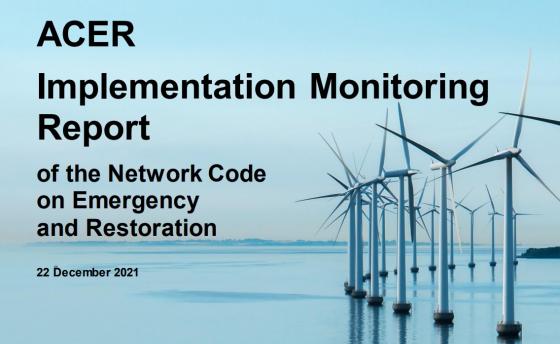ACER publishes the first Implementation Monitoring Report on the Emergency and Restoration Network Code

ACER publishes the first Implementation Monitoring Report on the Emergency and Restoration Network Code
What are the key findings?

ACER publishes today the first Implementation Monitoring Report (the Report) on progress in Member States in implementing the EU-wide Network Code on Electricity Emergency and Restoration.
This Network Code provides the requirements that Transmission System Operators (TSOs) must follow in electricity emergency, blackout and restoration states. If TSOs follow these rules when they face an incident on their grid it helps prevent incidents deteriorating into blackouts and allows for an efficient and rapid restoration of the electricity system to a normal state from the emergency or blackout states.
Key Findings:
ACER finds that while implementation of the electricity grid emergency and restoration rules is well on track (e.g. on regional coordination, on suspension and restoration of market activities and on tools and facilities), there is still not a complete and uniform EU-wide implementation of this legally binding Network Code. For example, there is still scope to improve:
-
Measures of the system defence plan that are to be implemented on the grid.
-
Measures of the restoration plans.
-
Assessment of the costs borne by system operators subject to network tariff regulation and stemming from the obligations laid down in the Network Code.
Why is it important to follow the electricity emergency and restoration rules?
A secure and efficient operation of the EU electricity system is a task shared between all the EU.
TSOs since all national systems are, to a certain extent, interconnected and a disturbance in one control area could affect another.
Hence, ACER underlines the importance of a correctly and fully implemented Emergency and Restoration Network Code to prevent the deterioration of an incident in a national system and to avoid the spread of disturbances to other areas and to enable swift restoration of the system back to normal state after a disturbance.
Hence, ACER underlines the importance of a correctly and fully implemented Emergency and Restoration Network Code to prevent the deterioration of an incident in a national system and to avoid the spread of disturbances to other control areas and to enable swift restoration of the system back to normal state after a disturbance.
ACER Recommendations:
ACER urges a prompt implementation of the articles of the Network Code that have already entered into force and invites the relevant NRAs to ensure a timely and complete application of the provisions that will apply as of 2022.


